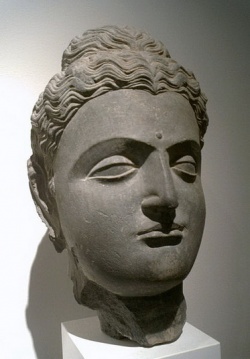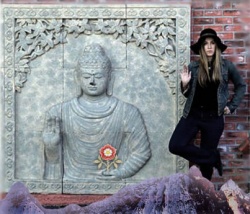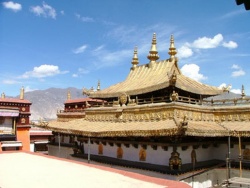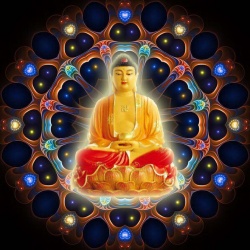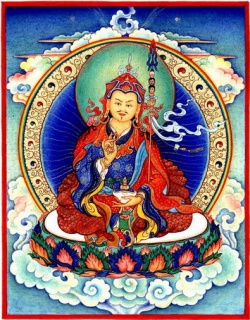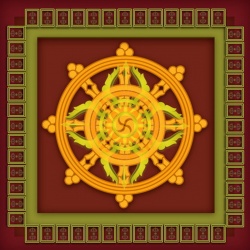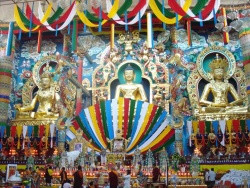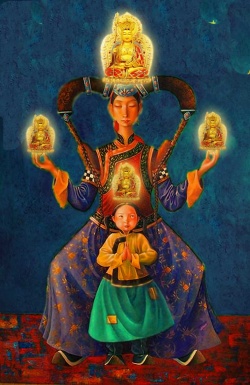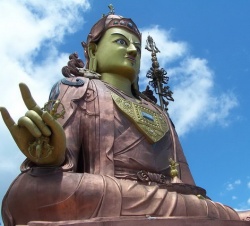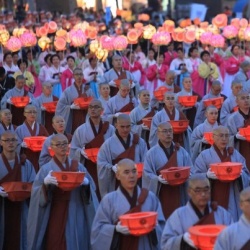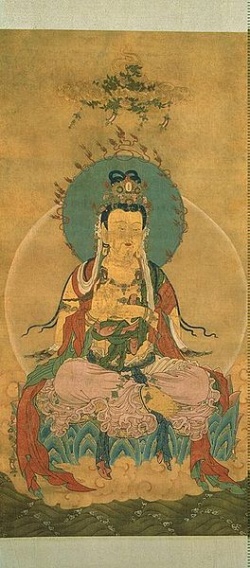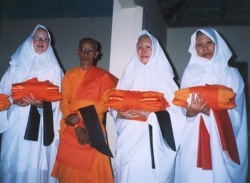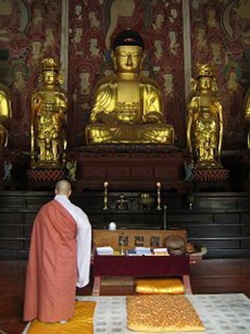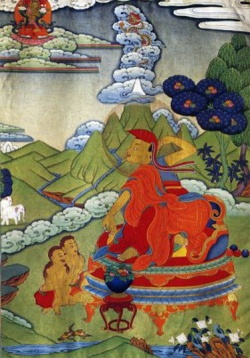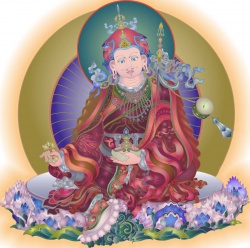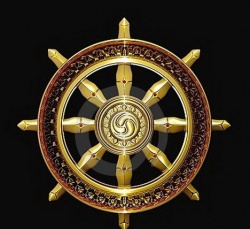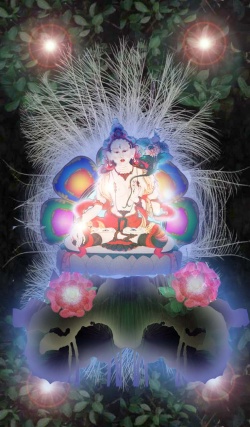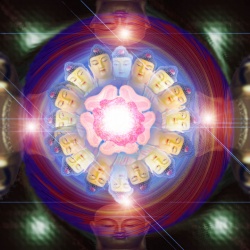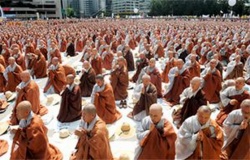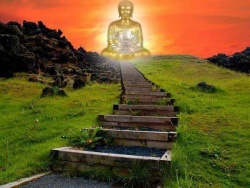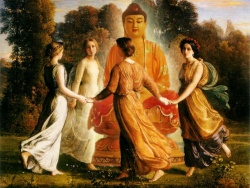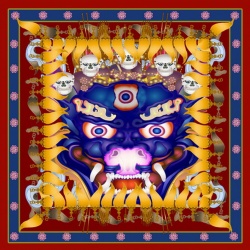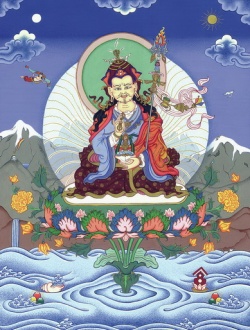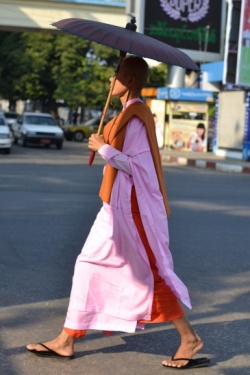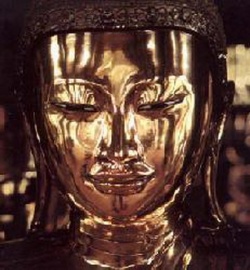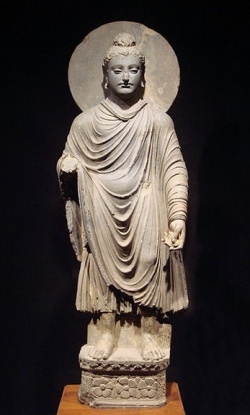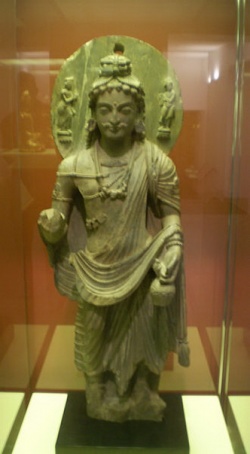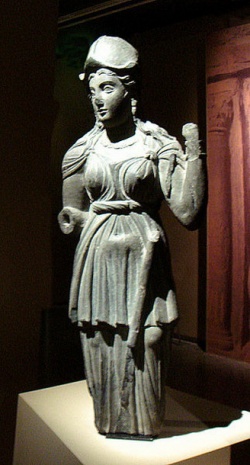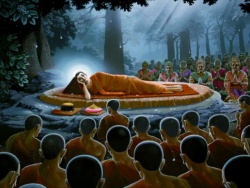Difference between revisions of "Schools of Buddhism"
m (Text replacement - "fourth" to "fourth") |
m (Text replacement - "]]]" to "]])") |
||
| Line 449: | Line 449: | ||
| − | [[Karma Kagyu]] (or ]]Kamtshang [[Kagyu]] | + | [[Karma Kagyu]] (or ]]Kamtshang [[Kagyu]])]) |
[[Tsalpa Kagyu]] | [[Tsalpa Kagyu]] | ||
[[Baram Kagyu]] | [[Baram Kagyu]] | ||
Latest revision as of 21:49, 4 April 2016
Buddhism (Pali/Sanskrit: बौद्ध धर्म Buddha Dharma) is an ancient ideological system that originated in Nepal, referred to variously throughout history by one or more of a myriad of concepts – including, but not limited to any of the following: a Dharmic religion, a philosophy or quasi-philosophical tradition, a spiritual schema, or a culturally dynamic psychological method of self-improvement.
The Buddhist faith was founded by the teacher Siddhārtha Gautama (Sanskrit: सिद्धार्थ गौतम; Pali: Siddhattha Gotama), known honorifically as the eponymic Buddha (born in Lumbini (Present day Nepal)), around the 6th or 5th century BCE.
The classification and nature of various doctrinal, philosophical or cultural facets or schools of Buddhism is vague and has been interpreted in many different ways, often due to the sheer number (perhaps thousands) of different sects, subsects, movements, etc. that have made up or currently make up the whole of Buddhist traditions.
The sectarian and conceptual divisions of Buddhic thought are part of the modern framework of Buddhist studies, as well as comparative religion in Asia.
From a largely English language standpoint, and to some extent in most of Western academia, Buddhism is separated into two groups at its foundation: Theravāda literally, "the Teaching of the Elders" or "the Ancient Teaching" and Mahāyāna.
The most common classification among scholars is threefold, with Mahāyāna split into East Asian (also known simply as Mahāyāna) and Vajrayāna, which includes Tibetan Buddhism and the Japanese Shingon school.
Classifications
The Macmillan Encyclopedia of Religion distinguishes three types of classification of Buddhism, separated into "Movements", "Nikāyas" and "Doctrinal schools":
Schools:
Theravada
Mahāyāna
Vajrayāna
Nikāyas, or monastic fraternities, three of which survive at the present day:
Theravāda, in Southeast Asia
Dharmaguptaka, in China, Korea and Vietnam
Mūlasarvāstivāda, in the Tibetan tradition
Doctrinal schools
Terminology
The terminology for the major divisions of Buddhism can be confusing, as Buddhism is variously divided by scholars and practitioners according to geographic, historical, and philosophical criteria, with different terms often being used in different contexts. The following terms may be encountered in descriptions of the major Buddhist divisions:
"Conservative Buddhism"
an alternative name for the early Buddhist schools.
"Early Buddhist schools"
the schools into which Buddhism became divided in its first few centuries; only one of these survives as an independent school, Theravāda
"East Asian Buddhism"
a term used by scholars to cover the Buddhist traditions of Japan, Korea, Singapore and most of China and Vietnam
"Eastern Buddhism"
an alternative name used by some scholars for East Asian Buddhism; also sometimes used to refer to all traditional forms of Buddhism, as distinct from Western(ized) forms.
"Esoteric Buddhism"
usually considered synonymous with "Vajrayāna". ] Some scholars have applied the term to certain practices found within the Theravāda, particularly in Cambodia.
"Hīnayāna"
literally meaning "lesser vehicle." It is considered a controversial term when applied by the Mahāyāna to mistakenly refer to the Theravāda school, and as such is widely viewed as condescending and pejorative.
Moreover, Hīnayāna refers to the now non extant schools with limited set of views, practices and results, prior to the development of the Mahāyāna traditions.
The term is currently most often used as a way of describing a stage on the path in Tibetan Buddhism, but is often mistakenly confused with the contemporary Theravāda tradition, which is far more complex, diversified and profound, than the literal and limiting definition attributed to Hīnayāna .
Its use in scholarly publications is now also considered controversial.
"Lamaism"
an old term, still sometimes used, synonymous with Tibetan Buddhism; widely considered derogatory.
"Mahāyāna"
a movement that emerged out of early Buddhist schools, together with its later descendants, East Asian and Tibetan Buddhism. Vajrayāna traditions are sometimes listed separately. The main use of the term in East Asian and Tibetan traditions is in reference to spiritual levels, regardless of school.
"Mainstream Buddhism"
a term used by some scholars for the early Buddhist schools.
"Mantrayāna"
usually considered synonymous with "Vajrayāna". The Tendai school in Japan has been described as influenced by Mantrayana.
"Newar Buddhism"
a non-monastic, caste based Buddhism with patrilineal descent and Sanskrit texts.
"Nikāya Buddhism" or "schools"
an alternative term for the early Buddhist schools.
"Non-Mahāyāna"
an alternative term for the early Buddhist schools.
"Northern Buddhism"
an alternative term used by some scholars for Tibetan Buddhism. Also, an older term still sometimes used to encompass both East Asian and Tibetan traditions. It has even been used to refer to East Asian Buddhism alone, without Tibetan Buddhism.
"Secret Mantra"
an alternative rendering of Mantrayāna, a more literal translation of the term used by schools in Tibetan Buddhism when referring to themselves.
"Sectarian Buddhism"
an alternative name for the early Buddhist schools.
"Southeast Asian Buddhism"
an alternative name used by some scholars for Theravāda.
"Southern Buddhism"
an alternative name used by some scholars for Theravāda.
"Śravakayāna"
an alternative term sometimes used for the early Buddhist schools.
"Tantrayāna" or "Tantric Buddhism"
usually considered synonymous with "Vajrayāna". However, one scholar describes the tantra divisions of some editions of the Tibetan scriptures as including Śravakayāna, Mahāyāna and Vajrayāna texts (see Buddhist texts). Some scholars , particularly François Bizot, have used the term "Tantric Theravāda" to refer to certain practices found particularly in Cambodia.
"Theravāda"
the traditional Buddhism of Sri Lanka, Burma, Thailand, Laos, Cambodia and parts of Vietnam, China, India, Bangladesh and Malaysia. It is the only surviving representative of the historical early Buddhist schools. The term "Theravāda" is also sometimes used to refer to all the early Buddhist schools.
"Tibetan Buddhism"
usually understood as including the Buddhism of Tibet, Mongolia, Bhutan and parts of China, India and Russia, which follow the Tibetan tradition.
"Vajrayāna"
a movement that developed out of Indian Mahāyāna, together with its later descendants. There is some disagreement on exactly which traditions fall into this category. Tibetan Buddhism is universally recognized as falling under this heading; many also include the Japanese Shingon school. Some scholars , also apply the term to the Korean milgyo tradition, which is not a separate school. One scholar says, "Despite the efforts of generations of Buddhist thinkers, it remains exceedingly difficult to identify precisely what it is that sets the Vajrayana apart."
Early schools
An image of Gautama Buddha with a swastika, a traditional Buddhist symbol of infinity, on his chest. Ananda, the Buddha's disciple, appears in the background. This statue is from Hsi Lai Temple.
Main articles: Nikaya Buddhism and Early Buddhist schools
Sthaviravāda
Pudgalavāda ('Personalist') (c. 280 BCE)
Sarvāstivāda
Vibhajyavāda (prior to 240 BCE; during Aśoka)
Theravāda (c. 240 BCE)
Theravāda subschools (see below)
Mahīśāsaka (after 232 BCE)
Dharmaguptaka (after 232 BCE)
Kāśyapīya (after 232 BCE)
Vatsīputrīya (under Aśoka) later name: Saṃmitīya
Dharmottarīya
Bhadrayānīya
Sannāgarika
Mūlasarvāstivāda (third and fourth centuries)
Sautrāntika (between 50 BCE and c. 100 CE)
Mahāsāṃghika ('Majority', c. 380 BCE
)
Ekavyahārikas (under Aśoka
)
Lokottaravāda
Golulika (during Aśoka)
Bahuśrutīya (late third century BCE)
Prajñaptivāda (late third century BCE)
Cetiyavāda
Caitika (mid-first century BCE)
Apara Śaila
Uttara Śaila
Twenty sects
The following lists the twenty sects described as Hīnayāna, as the classification is understood in some Mahāyāna texts:
Sthaviravāda split into the 11 sects:
Sarvāstivādin
Haimavata
Vatsīputrīya
Dharmottara
Bhadrayānīya
Sammitiya
Channagirika
Mahīśāsaka
Dharmaguptaka
Kāśyapīya
Sautrāntika
Influences on East Asian schools
The following later schools used the vinaya of the Dharmaguptaka:
Chinese Buddhism, especially the Vinaya School
Korean Buddhism, especially Gyeyul
Vietnamese Buddhism
Japanese Ritsu
The following involve philosophical influence:
The Japanese Jojitsu is considered by some an offshoot of Sautrāntika; others consider it to be derived from Bahuśrutīya
The Chinese/Japanese Kusha school is considered an offshoot of Sarvāstivāda, influenced by Vasubandhu.
Theravāda subschools
Samādhi Buddha statue at Mahamevuna Park in Anuradhapura, Sri Lanka carved in the 4th century AD.
The different schools in Theravāda often emphasize different aspects (or parts) of the Pāli canon and the later commentaries, or differ in the focus on and recommended way of practice. There are also significant differences in strictness or interpretation of the vinaya.
Bangladesh:
Sangharaj Nikaya
Mahasthabir Nikaya
Burma:
Thudhamma Nikaya
Vipassanā tradition of Mahasi Sayadaw and disciples
Shwegyin Nikaya
Dvaya Nikaya or Dvara Nikaya (see Mendelson, Sangha and State in Burma, Cornell University Press, Ithaca, New York, 1975)
Sri Lanka:
Siam Nikaya
Waturawila (or Mahavihara Vamshika Shyamopali Vanavasa Nikaya)
Amarapura Nikaya
Kanduboda (or Swejin Nikaya)
Tapovana (or Kalyanavamsa)
Ramañña Nikaya
Sri Kalyani Yogasrama Samstha (or ‘Galduwa Tradition’)
Delduwa
forest nikaya
Thailand
Maha Nikaya
Dhammakaya Movement
[[Mahasati meditation (mindfulness meditation)
Thammayut Nikaya
Thai Forest Tradition
Tradition of Ajahn Chah
Mahāyāna schools
Chinese Glazed stoneware of a Buddhist monk, or Future Buddha, dated to the 20th year of the Chenghua Emperor, or 1468 AD.
Tibetan Buddhism
Mādhyamaka
Prāsangika
Svātantrika
Sanlun (Three Treatise school)
Sanron
Mahā-Mādhyamaka (Jonangpa)
Yogācāra
Cittamātra in Tibet
Wei-Shi (Consciousness-only school) or Faxiang (Dharma-character school)
Beopsang
Hossō
Tathāgatagarbha
Daśabhūmikā (absorbed into Huayan)
Huayan (Avataṃsaka)
Hwaeom
Kegon
Chan / Zen / Seon / Thien
Caodong
Sōtō
Keizan line
Jakuen line
Giin line
Linji
Rinzai
Ōbaku
Fuke
Won Buddhism: Korean Reformed Buddhism
Pure land (Amidism)
Jōdo-shū
Jōdo Shinshū
Tiantai (Lotus Sutra School)
Cheontae
Tendai (also contains Vajrayana elements)
Nichiren
Nichiren Shū
Nichiren Shōshū
Nipponzan Myōhōji
Sōka Gakkai
Tantric schools
See also: Vajrayāna
Subcategorised according to predecessors
Nyingma
New Bön (synthesis of Yungdrung Bön and Nyingmapa)
Kadam
Sakya
Ngor-pa
Tsar-pa
Jonang
Gelug
Kagyu:
Shangpa Kagyu
Marpa Kagyu:
Rechung Kagyu
Dagpo Kagyu:
Karma Kagyu (or ]]Kamtshang Kagyu)])
Tsalpa Kagyu
Baram Kagyu
Pagtru Kagyu (or Phagmo Drugpa Kagyu):
Taklung Kagyu
Trophu Kagyu
Drukpa Kagyu
Martsang Kagyu
Yerpa Kagyu
Yazang Kagyu
Shugseb Kagyu
Drikung Kagyu
Rime movement (ecumenical movement)
Newar Buddhism
Japanese Mikkyo
Shingon
Tendai (derived from Tiantai but added tantric practices)
Shinnyo-en
New Buddhist movements
Aum Shinrikyo (now known as Aleph)
Diamond Way
Triratna Buddhist Community
New Kadampa Tradition
Share International
True Buddha School
Vipassana movement
Shambhala Buddhism
Source
<poem>
Written by Thư Viện Quang Minh
Friday, 16 April 2010 10:14
Schools of Buddhism are classified in various ways. Normal English-language usage (as given in dictionaries) divides Buddhism into Theravāda (also known by the name "Hīnayāna", which many consider pejorative) and Mahāyāna.
The most common classification among scholars is threefold, with Mahāyāna split into East Asian (also known simply as Mahāyāna) and Vajrayāna, or Tibetan Buddhism (although Vajrayāna properly includes the Japanese Shingon school).
Classifications
The Macmillan Encyclopedia of Religion distinguishes three types of classification of Buddhism:
Movements:
Hīnayāna
Mahāyāna
Vajrayāna
Nikayās, or monastic fraternities, three of which survive at the present day:
Theravāda, in Southeast Asia
Dharmaguptaka, in China, Korea and Vietnam
Mūlasarvāstivāda, in the Tibetan tradition
Doctrinal schools
Terminology
The terminology for the major divisions of Buddhism can be confusing, as Buddhism is variously divided by scholars and practitioners according to geographic, historical, and philosophical criteria, with different terms often being used in different contexts.
The following terms may be encountered in descriptions of the major Buddhist divisions:
"Conservative Buddhism" an alternative name for the early Buddhist schools.
"Early Buddhist Schools" the schools into which Buddhism became divided in its first few centuries; only one of these survives as an independent school, Theravāda
"East Asian Buddhism" a term used by scholars[1] to cover the Buddhist traditions of Japan, Korea, Singapore and most of China and Vietnam
"Eastern Buddhism" an alternative name used by some scholars[2][page needed] for East Asian Buddhism; also sometimes used to refer to all traditional forms of Buddhism, as distinct from Western(ized) forms.
"Esoteric Buddhism" usually considered synonymous with "Vajrayāna".[3] Some scholars have applied the term to certain practices found within the Theravāda, particularly in Cambodia.[4][page needed]
"Hīnayāna" often interpreted as a pejorative term, used in Mahāyāna doctrine to denigrate its opponents.[5] It is sometimes used to refer to the early Buddhist schools, including the contemporary Theravāda, although the legitimacy of this is disputed.[6] Its use in scholarly publications is controversial.[7]
By the Mahāyāna schools and groups in China, Korea, Tibet, and Japan the term is felt to be only slightly pejorative, or not pejorative at all.[8]
By some it is used with respect proper to teachings coming direct from the Buddha. The main use of the term in East Asian and Tibetan traditions is in reference to spiritual levels[9] regardless of school.
The literal meaning of "Hīnayāna" can also be "the small vehicle," referring to a raft meant to carry one person, as an arhat, to nirvana through their own effort, in contrast to the "large vehicle" of Mahāyāna meant to carry many there at once, piloted by a bodhisattva.
"Lamaism" an old term, still sometimes used, synonymous with Tibetan Buddhism; widely considered derogatory.
"Mahāyāna" a movement that emerged out of early Buddhist schools, together with its later descendants, East Asian and Tibetan Buddhism. Vajrayāna traditions are sometimes listed separately.
The main use of the term in East Asian and Tibetan traditions is in reference to spiritual levels,[10][page needed] regardless of school.
"Mainstream Buddhism" a term used by some scholars for the early Buddhist schools.
"Mantrayāna" usually considered synonymous with "Vajrayāna".[11] The Tendai school in Japan has been described as influenced by Mantrayana.[10][page needed]
"Newar Buddhism" a non-monastic, caste based Buddhism with patrilineal descent and Sanskrit texts.
"Nikāya Buddhism" or "schools" an alternative term for the early Buddhist schools.
"Non-Mahāyāna" an alternative term for the early Buddhist schools.
"Northern Buddhism" an alternative term used by some scholars[2][page needed] for Tibetan Buddhism.
Also, an older term still sometimes used to encompass both East Asian and Tibetan traditions.
It has even been used to refer to East Asian Buddhism alone, without Tibetan Buddhism.
"Secret Mantra" an alternative rendering of Mantrayāna, a more literal translation of the term used by schools in Tibetan Buddhism when referring to themselves.[12]
"{Sectarian Buddhism" an alternative name for the early Buddhist schools.
"{Southeast Asian Buddhism" an alternative name used by some scholars[13][page needed] for Theravāda.
"Southern Buddhism" an alternative name used by some scholars[2][page needed] for Theravāda.
"Śravakayāna" an alternative term sometimes used for the early Buddhist schools.
"Tantrayāna" or "Tantric Buddhism" usually considered synonymous with "Vajrayāna".[11]
However, one scholar describes the tantra divisions of some editions of the Tibetan scriptures as including Śravakayāna, Mahāyāna and Vajrayāna texts[14] (see Buddhist texts).
Some scholars[15][page needed], particularly François Bizot,[16] have used the term "Tantric Theravāda" to refer to certain practices found particularly in Cambodia.
"Theravāda" the traditional Buddhism of Sri Lanka, Burma, Thailand, Laos, Cambodia and parts of Vietnam, China, India, Bangladesh and Malaysia.
It is the only surviving representative of the historical early Buddhist schools. The term "Theravāda" is also sometimes used to refer to all the early Buddhist schools.[17]
"Tibetan Buddhism" usually understood as including the Buddhism of Tibet, Mongolia, Bhutan and parts of China, India and Russia, which follow the Tibetan tradition.
"Vajrayāna" a movement that developed out of Indian Mahāyāna, together with its later descendants.
There is some disagreement on exactly which traditions fall into this category. Tibetan Buddhism is universally recognized as falling under this heading; many also include the Japanese Shingon school.
Some scholars[18][page needed], also apply the term to the Korean milgyo tradition, which is not a separate school.
One scholar says, "Despite the efforts of generations of Buddhist thinkers, it remains exceedingly difficult to identify precisely what it is that sets the Vajrayana apart."[19]
Early schools
An image of Gautama Buddha with a swastika, a traditional Buddhist symbol of infinity, on his chest.
Ananda, the Buddha's disciple, appears in the background.
This statue is from Hsi Lai Temple.
Main articles: Nikaya Buddhism and Early Buddhist schools
Sthaviravāda
Pudgalavāda ('Personalist') (c. 280 BCE)
Sarvāstivāda
Vibhajjavāda (prior to 240 BCE; during Aśoka)
Theravāda (c. 240 BCE)
Theravāda subschools (see below)
Mahīśāsaka (after 232 BCE)
Dharmaguptaka (after 232 BCE)
Kāśyapīya (after 232 BCE)
Vatsīputrīya (under Aśoka) later name: Saṃmitīya
Dharmottarīya
Bhadrayānīya
Sannāgarika
Mūlasarvāstivāda (third and fourth centuries)
Sautrāntika (between 50 BCE and c. 100 CE)
Mahāsaṃghika ('Majority', c. 380 BCE)
Ekavyahārikas (under Aśoka)
Lokottaravāda
Golulika (during Aśoka)
Bahuśrutīya (late third century BCE)
Prajñaptivāda (late third century BCE)
Cetiyavāda
Caitika (mid-first century BCE)
Apara Śaila
Uttara Śaila
Twenty sects
The following lists the twenty sects described as Hīnayāna in some Mahāyāna texts:
Sthaviravāda (上座部) split into the 11 sects:
說一切有部(Sarvāstivādin)
雪山部(Haimavata)
犢子部(Vatsīputrīya)
法上部 (Dharmottara)
賢冑部(Bhadrayānīya)
正量部(Sammitiya)
密林山部(Channagirika)
化地部 (Mahīśāsaka)
[[法藏部(Dharmaguptaka)
飲光部(Kāśyapīya)
經量部(Sautrāntika)
Mahāsaṃghika (大眾部) split into 9 sects:
一說部(Ekavyahārika)
說出世部(Lokottaravādin)
雞胤部 (Kaukkutika)
多聞部(Bahuśrutīya)
說假部(Prajñaptivāda)
制多山部(Caitika)
西山住部 (Aparaśaila)
北山住部(Uttaraśaila).
Influences on East Asian schools
The following later schools used the vinaya of the Dharmaguptaka:
Chinese Buddhism, especially the Vinaya School
Korean buddhism, especially Gyeyul
Vietnamese Buddhism
Japanese Ritsu
The following involve philosophical influence:
The Japanese Jojitsu is considered by some an offshoot of Sautrāntika; others consider it to be derived from Bahuśrutīya
The Chinese/Japanese Kusha school is considered an offshoot of Sarvāstivāda, influenced by Vasubandhu.
Theravāda subschools
The different schools in Theravāda often emphasize different aspects (or parts) of the Pāli canon and the later commentaries, or differ in the focus on and recommended way of practice. There are also significant differences in strictness or interpretation of the Vinaya .
Bangladesh
Sangharaj Nikaya
Mahasthabir Nikaya
Burma:
Thudhamma Nikaya
Vipassana tradition of Mahasi Sayadaw and disciples
Shwekyin Nikaya
Dvaya Nikaya or Dvara Nikaya (see Mendelson, Sangha and State in Burma, Cornell University Press, Ithaca, New York, 1975)
Sri Lanka:
Siam Nikaya
Waturawila (or Mahavihara Vamshika Shyamopali Vanavasa Nikaya)
Amarapura Nikaya
Kanduboda (or Swejin Nikaya)
[[Tapovana[[ (or Kalyanavamsa)
Ramañña Nikaya
Galduwa (or Kalyana Yogashramaya Samsthava)
Delduwa
Forest Nikaya
Thailand
Maha Nikaya
Dhammakaya Movement
Thammayut Nikaya
Thai Forest Tradition
Tradition of Ajahn Chah
Mahāyāna schools
Mādhyamaka
Prāsangika
Svātantrika
Sanlun (Three Treatise school)
Sanron
Mahā-Mādhyamaka (Jonangpa)
Yogācāra
Cittamātra in Tibet
Wei-Shi (Consciousness-only school) or Faxiang (Dharma-character school
Beopsang
Hossō
Tathāgatagarbha
Daśabhūmikā (absorbed into Huayan)
Huayan (Avataṃsaka)
Hwaeom
Kegon
Chan / Zen / Seon / Thien
Caodong
Sōtō
Keizan line
Jakuen line
Giin line
Linji
Rinzai
Ōbaku
Fuke
Won Buddhism: Korean Reformed Buddhism
Pure Land (Amidism)
Jodo Shu
Jodo Shinshu
Tiantai (Lotus Sutra School)
Cheontae Tendai (also contains Vajrayana elements)
Tendai (also contains Vajrayana elements)
Nichiren
Nichiren Shū
Nichiren Shōshū
Nipponzan Myōhōji
Soka Gakkai
Tantric schools
see also: Vajrayāna Subcategorised according to predecessors
Tibetan Buddhism
Nyingma
New Bön (synthesis of Yungdrung Bön and Nyingmapa)
Kadam
Sakya
Ngor-pa
Tsar-pa
Jonang
Gelug
Kagyu:
Shangpa Kagyu
Marpa Kagyu:
Rechung Kagyu
Dagpo Kagyu:
Karma Kagyu (or Kamtshang Kagyu)
Tsalpa Kagyu
Baram Kagyu
Pagtru Kagyu (or Phagmo Drugpa Kagyu):
Taglung Kagyu
Trophu Kagyu
Drukpa Kagyu
Martsang Kagyy
Yerpa Kagyu
Yazang Kagyu
Shugseb Kagyu
Drikung Kagyu
Rime movement (ecumenical movement)
Japanese Mikkyo
Shingon
Tendai (derived from Tiantai but added tantric practices)
Shinnyo-en
New Buddhist movements
Aum Shinrikyo (now known as Aleph)
Diamond Way
Friends of the Western Buddhist Order
New Kadampa Tradition
Share International
True Buddha School
Vipassana movement
Shambhala Buddhism
References
^ B & G, Gethin, R & J, P & K
^ a b c Penguin, Harvey
^ Encyclopedia of Religion, Macmillan, New York, volume 2, page 440
^ Indian Insights, Luzac, London, 1997
^ "Hinayana (literally, 'inferior way') is a polemical term, which self-described Mahāyāna (literally, 'great way') Buddhist literature uses to denigrate its opponents." - p. 840, MacMillan Library Reference Encyclopedia of Buddhism, 2004
^ "Hinayana is a designation that has no clearly identifiable external referent" - p. 840, MacMillan Library Reference Encyclopedia of Buddhism, 2004
^ "The supposed Mahayana-Hinayana dichotomy is so prevalent in Buddhist literature that it has yet fully to loosen its hold over scholarly representations of the religion." - p. 840, MacMillan Library Reference Encyclopedia of Buddhism, 2004
^ "It is also certain that Buddhist groups and individuals in China, Korea, Tibet, and Japan have in the past, as in the very recent present, identified themselves as Mahayana Buddhists, even if the polemical or value claim embedded in that term was only dimly felt, if at all.": Macmillan Encyclopedia of Buddhism, 2004, page 492
^ Penguin Handbook, pages 378f
^ a b Penguin Handbook
^ a b Harvey, pages 153ff
^ Hopkins, Jeffrey (1985) The Ultimate Deity in Action Tantra and Jung's Warning against Identifying with the Deity Buddhist-Christian Studies, Vol. 5, (1985), pp. 159-172
^ R & J, P & K
^ Skilling, Mahasutras, volume II, Parts I & II, 1997, Pali Text Society, Lancaster, page 78
^ Indian Insights, loc. cit.
^ Crosby, Kate( 2000)Tantric Theravada: A bibliographic essay on the writings of François Bizot and others on the yogvacara Tradition. In Contemporary Buddhism, 1:2, 141—198[1]
^ Encyclopedia of Religion, volume 2, Macmillan, New York, 1987, pages 440f; Cambridge Dictionary of Philosophy, sv Buddhism ^ Harvey
^ Lopez, Buddhism in Practice, Princeton University Press, 1995, page 6
Coleman, Graham, ed. (1993). A Handbook of Tibetan Culture. Boston: Shambhala Publications, Inc.. ISBN 1-57062-002-4.
Warder, A.K. (1970). Indian Buddhism. Delhi: Motilal Banarsidass.
